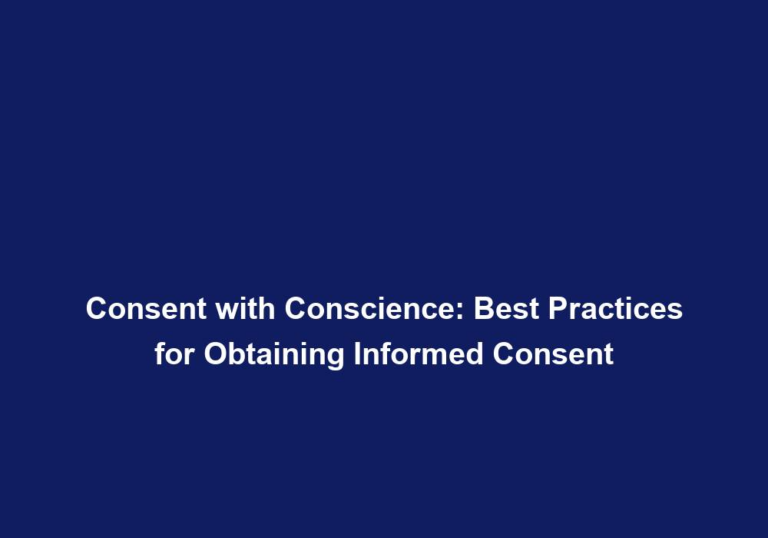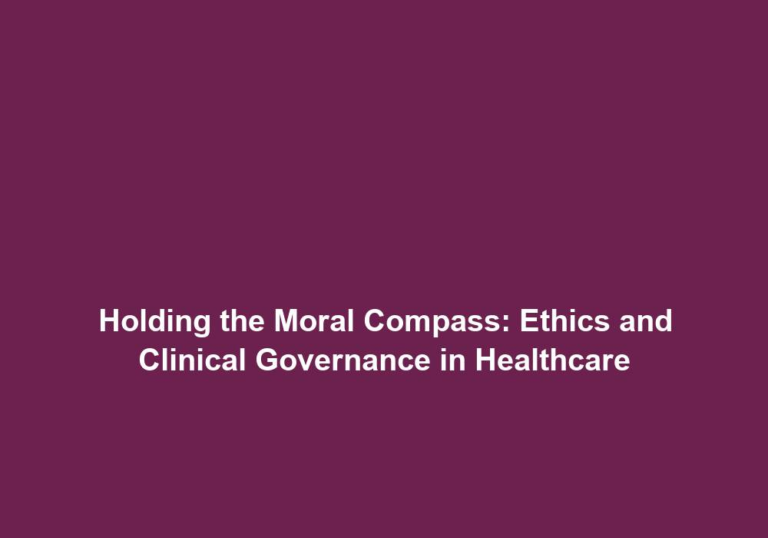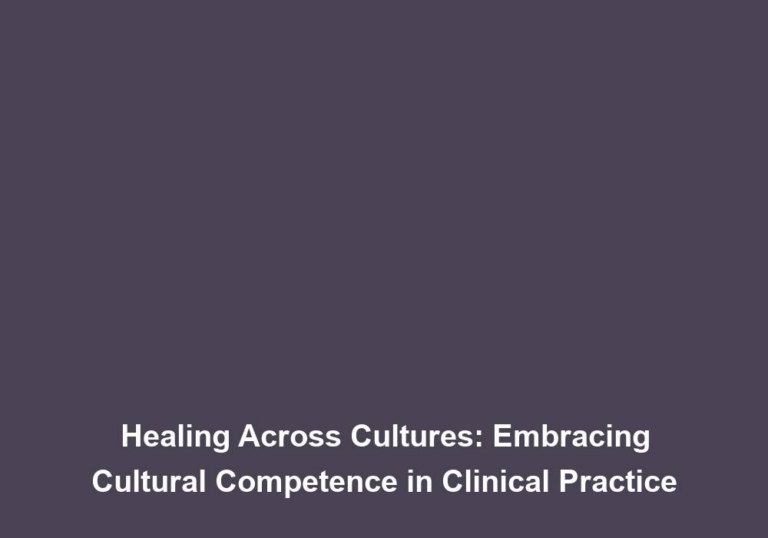From Principle to Practice: Ensuring Patient Safety with Ethical Governance
Patient safety is a fundamental aspect of healthcare delivery and is crucial for providing high-quality care. In recent years, the focus on patient safety has grown significantly, highlighting the need for ethical governance to ensure that healthcare organizations prioritize the well-being of their patients.
The Importance of Patient Safety
Patient safety refers to the proactive measures taken to minimize the risk of harm or injury to patients during healthcare encounters. It encompasses various aspects, including medication errors, surgical complications, infections, misdiagnosis, and communication breakdowns. Ensuring patient safety is essential as it directly impacts the overall effectiveness and credibility of healthcare systems.
Patient safety is not only crucial for preventing harm to individual patients but also for creating a culture of trust and confidence in healthcare organizations. When patients feel safe, they are more likely to seek medical care and follow recommended treatments. It also reduces the financial burden on healthcare systems by preventing costly adverse events and legal disputes.
Ethical Governance: A Framework for Patient Safety
Ethical governance provides a comprehensive framework that guides healthcare organizations in prioritizing patient safety and integrating ethical principles into their practices. It involves adopting policies, procedures, and protocols that promote patient-centered care, transparency, accountability, and continuous improvement.
Key Elements of Ethical Governance
- Ethical Leadership: Ethical governance begins with strong leadership committed to upholding ethical principles. Leaders set the tone for the organization by fostering a culture of safety, trust, and ethical behavior. They establish clear expectations and empower healthcare professionals to prioritize patient safety in their daily practices.
Leadership plays a crucial role in shaping the ethical culture within healthcare organizations. They should lead by example, demonstrating ethical behavior and promoting open communication. By fostering a culture of safety and trust, leaders can empower healthcare professionals to make ethical decisions and prioritize patient safety at all levels of care.
- Ethical Decision-Making: Healthcare professionals often face complex ethical dilemmas that require careful consideration. Ethical governance provides a decision-making framework that guides healthcare providers in resolving these dilemmas while prioritizing patient safety. It encourages open dialogue, collaboration, and ethical reasoning to ensure the best outcomes for patients.
Ethical decision-making requires healthcare professionals to consider the potential risks and benefits of different courses of action. They must weigh the ethical principles of autonomy, beneficence, non-maleficence, and justice to ensure patient safety. Collaborating with interdisciplinary teams and seeking input from patients and their families can also help in making ethically sound decisions.
- Patient Engagement and Empowerment: Ethical governance recognizes the importance of involving patients in their care. It promotes shared decision-making, informed consent, and patient education to empower individuals to actively participate in their healthcare journey. By engaging patients as partners, healthcare organizations can enhance patient safety and improve overall outcomes.
Patient engagement is crucial for patient safety as it allows for a better understanding of individual patient needs, preferences, and concerns. It promotes effective communication between healthcare providers and patients, ensuring that patients are actively involved in decisions about their care. This collaborative approach leads to better adherence to treatment plans, reduced medical errors, and improved patient satisfaction.
- Transparency and Accountability: Ethical governance emphasizes the need for transparency and accountability in healthcare organizations. It encourages the reporting of adverse events, near misses, and medical errors, fostering a culture of learning from mistakes rather than blaming individuals. By openly addressing errors and implementing corrective actions, organizations can continuously improve and prevent future occurrences.
Transparency and accountability are essential for building trust with patients and the wider community. When healthcare organizations are transparent about adverse events and errors, they demonstrate a commitment to learning and improvement. This transparency allows for the identification of systemic issues and the implementation of strategies to prevent similar incidents in the future.
- Continuous Quality Improvement: Ethical governance promotes a culture of continuous quality improvement. It involves regularly assessing and monitoring patient safety outcomes, conducting root cause analyses, and implementing evidence-based practices. By systematically identifying areas for improvement and implementing proactive measures, healthcare organizations can enhance patient safety and prevent adverse events.
Continuous quality improvement is an ongoing process that involves monitoring and evaluating patient safety measures. This includes analyzing data, identifying trends, and implementing strategies to address areas of concern. By regularly reviewing and updating policies and procedures, healthcare organizations can stay current with best practices and ensure the delivery of safe and effective care.
Implementing Ethical Governance in Healthcare Organizations
To ensure patient safety through ethical governance, healthcare organizations should consider the following steps:
- Developing Ethical Policies and Procedures: Establish clear ethical policies and procedures that align with organizational values and ethical standards. These guidelines should address patient safety, confidentiality, informed consent, and ethical decision-making.
Ethical policies and procedures provide a framework for healthcare professionals to navigate ethical dilemmas and ensure patient safety. They should be comprehensive, easily accessible, and regularly updated to reflect changes in healthcare practices and regulations.
- Training and Education: Provide ongoing training and education programs to healthcare professionals to enhance their understanding of ethical governance principles and their role in ensuring patient safety. These programs should address ethical dilemmas, communication skills, and patient engagement strategies.
Training and education programs help healthcare professionals develop the knowledge and skills necessary to make ethically sound decisions. They should cover topics such as ethical reasoning, communication and collaboration, and conflict resolution. Ongoing education ensures that healthcare professionals stay updated with the latest advancements in patient safety and ethical practices.
- Promoting a Culture of Safety: Foster a culture of safety by encouraging open communication, reporting of adverse events, and learning from mistakes. Encourage healthcare professionals to actively participate in patient safety initiatives and provide feedback on system improvements.
Creating a culture of safety requires a supportive environment where healthcare professionals feel comfortable speaking up about potential risks and errors. It involves promoting open communication channels, encouraging the reporting of incidents, and providing feedback on safety concerns. By fostering a culture of safety, healthcare organizations can identify and address potential risks before they harm patients.
- Regular Audits and Assessments: Conduct regular audits and assessments to evaluate the effectiveness of ethical governance practices and identify areas for improvement. This may involve reviewing incident reports, analyzing patient safety data, and soliciting feedback from patients and healthcare professionals.
Regular audits and assessments help healthcare organizations identify gaps in patient safety practices and implement necessary improvements. They provide an opportunity to review policies, procedures, and protocols to ensure they align with ethical standards and best practices. By continuously monitoring patient safety outcomes, healthcare organizations can proactively identify potential risks and implement measures to mitigate them.
- Collaboration and Partnerships: Collaborate with other healthcare organizations, regulatory bodies, and patient advocacy groups to share best practices, exchange knowledge, and collectively work towards enhancing patient safety. Engage in partnerships that promote ethical governance and patient-centered care.
Collaboration and partnerships facilitate the sharing of experiences, resources, and expertise in patient safety. By working together, healthcare organizations can learn from each other’s successes and challenges, driving continuous improvement in patient safety practices. Collaboration with regulatory bodies and patient advocacy groups also helps in staying updated with regulatory requirements and incorporating patient perspectives into decision-making processes.
The Benefits of Ethical Governance in Ensuring Patient Safety
By implementing ethical governance practices, healthcare organizations can reap several benefits, including:
- Improved Patient Outcomes: Ethical governance prioritizes patient safety, leading to improved clinical outcomes and decreased adverse events. Patients can trust that their healthcare providers are committed to their well-being and will prioritize their safety above all else.
When patient safety is a top priority, healthcare organizations can reduce the occurrence of preventable harm and improve overall patient outcomes. This includes fewer medication errors, surgical complications, and healthcare-associated infections. By implementing ethical governance practices, healthcare providers can deliver high-quality care that meets the needs and expectations of their patients.
- Enhanced Organizational Reputation: A strong commitment to patient safety through ethical governance enhances an organization’s reputation. Patients and their families are more likely to choose healthcare providers that prioritize their safety and well-being.
Ethical governance helps build trust and confidence in healthcare organizations. When patients feel safe and well-cared for, they are more likely to recommend the organization to others and have a positive perception of its services. This positive reputation can attract new patients and contribute to the long-term success of the organization.
- Higher Staff Satisfaction: Ethical governance fosters a positive work environment where healthcare professionals feel valued and supported. It empowers them to deliver safe and ethical care, leading to higher job satisfaction and reduced burnout rates.
When healthcare professionals work in an environment that prioritizes patient safety, they feel more fulfilled in their roles. Ethical governance practices provide healthcare professionals with the necessary support and resources to deliver high-quality care without compromising their ethical standards. This leads to increased job satisfaction, improved morale, and reduced turnover rates.
- Cost Savings: By focusing on patient safety and preventing adverse events, healthcare organizations can reduce the financial burden associated with medical errors, litigation, and prolonged hospital stays.
Ethical governance practices can help healthcare organizations save costs by preventing costly adverse events and their associated expenses. Preventing medical errors and complications reduces the need for additional treatments, hospital readmissions, and legal disputes. By investing in patient safety initiatives, organizations can achieve long-term cost savings and allocate resources more efficiently.
Conclusion
Ethical governance plays a vital role in ensuring patient safety in healthcare organizations. By prioritizing patient-centered care, transparency, accountability, and continuous improvement, healthcare professionals can provide high-quality care while minimizing the risk of harm to patients. Implementing ethical governance practices strengthens organizational culture, improves patient outcomes, and enhances the overall reputation of healthcare organizations.







